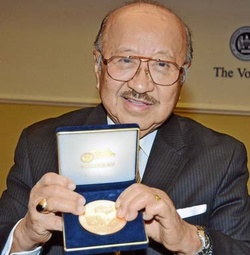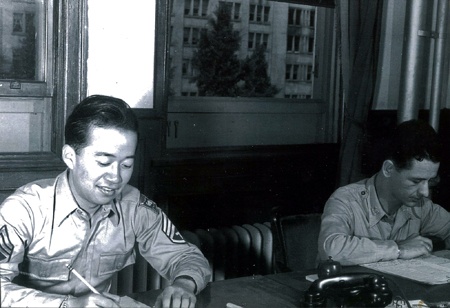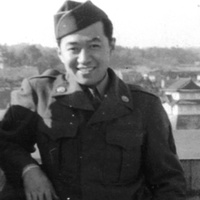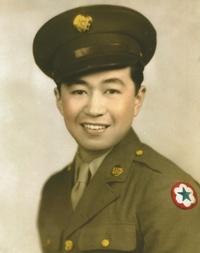Talk given at the Placer County Ceremony Honoring Japanese American Veteran Recipients of the Congressional Gold Medal, and Recipients of the Bronze Star, in World War II. November 7, 2012.

James Iso with the Congressional Gold Medal he received at the Congressional Ceremony, Washington, DC in November 2011.
Today, we are immensely honored, as recipients of the Congressional Gold Medal, bestowed upon us by the Congress of the United States, for as they put it, “a job well done” in our patriotic accomplishments for the United States in World War II. Being among the dwindling, surviving members of Japanese Americans veterans who served in that war, I am indeed privileged to speak on behalf of our Nisei comrades who fought gallantly and honorably for our country in that world conflict.
Some 67 years have rolled by since the end of WWII. For we surviving Nisei veterans, our eyes today may have grown dimmer, but our recollections remain vivid. You may be assured, the common mission and bond among Nisei in uniform of that day, was to overcome the severe adverse stigma of the war which had befallen upon all Japanese Americans. In those traumatic days, we may have been young and impetuous, but our resolve was absolute; we felt we had a mission we had to fulfill.
In our today’s world, and in our today’s generation, we wonder whether our Japanese American offspring and grandchildren truly understand the circumstances of that time, and the motivation, thinking, and endeavors of our actions? We senior veterans have long wondered: “do they truly know what motivated us, to be willing to sacrifice so much?”—with the start of the war with Japan and the Axis powers, the ethnic discrimination against Japanese Americans and resident Japanese in all walks of life in our society was brutal, appalling, and humiliating beyond description. We suddenly were the enemy!
We Nisei of that time also held great concerns as to how the American society and government would look upon future generations of Japanese Americans if the prevailing attitude prevailed after the war. “Would they be looked upon as a disloyal racial group? …Or cowardly, if we Nisei did not serve in the military under the prevailing discriminatory atmosphere?” The stakes were high. From behind our barbed wired enclosed camps in which we Japanese Americans were incarcerated, we had to somehow prove beyond any shadow of doubt our patriotism, our loyalty, and love of America. This message had to be conveyed to our fellow Americans and to the government, and soundly proven by our performances on the battlefields.
For the better understanding of our younger generation attending here today, allow me to briefly explain how we Nisei responded. Through the leadership of the Japanese American Citizens League (JACL) in Washington, DC, and support from select members of our US Congress of that time, Japanese Americans from the 10 internment camps (consisting of 110,000 internees), were finally allowed in 1943 to volunteer for military duty.
For most of we military age internees, this was the opportunity we had sought, to “show our colors,” to prove loyalty and patriotism to country. Young volunteers eagerly stepped forward, and the military draft that subsequently followed, filled the ranks of manning needed to establish the Nisei 442nd Regimental Combat Team, that succeed the Nisei 100th Infantry Battalion in Europe. From the internment camps also came the volunteers and recruits for the “army military intelligence language school” whose graduates performed military intelligence, language translation, and interpreting operations (MIS) in the front lines throughout the Pacific war against Japan (I was among the MIS group).
The MIS operations in the Pacific war was such a great success that General Douglas MacArthur’s intelligence commander, General Charles Willoughby, declared at war’s end, “The Nisei military intelligence operations and contributions in the Pacific saved over 1,000,000 American lives, and shortened the war by two years. They collected information on the battlefield; they shared death in battle.” However, military intelligence security prevented divulgence of MIS’s many accomplishments until many years later.

James Iso with Capt. Bob Pedlow, G-2, Intelligence Headquarters in General MacArthur's GHQ, in Tokyo, 1945
What are common knowledge of Nisei MIS operations in the Pacific, range from: assisting in the cracking of the Japanese military secret communication code; which in turn assisted in the interception and shooting down the aircraft carrying Japan’s military commander Admiral lsoroku Yamamoto during his troop inspection mission to the Pacific islands; translation of captured Japanese navy’s secret war plans, which led to the U.S. Navy’s major sea victory in the “Battle of Midway.”
On the European theater of war, military records show that the Nisei 442nd Regimental Combat Team, together with the 100th, was the most highly decorated army unit of its size in all of US military history. Among the accomplishments were:
- 7 presidential unit citations for battlefield successes
- 9,486 Purple Hearts (wounded in action)
- 21 individual Medals of Honor for valor in battle
- 18,142 individual decorations for combat action & valor
- There were also 832 soldiers killed in action
At war’s end, the 442nd marched down Pennsylvania Avenue, in Washington, DC to the White House. There President Harry Truman presented the unit the colors for the 7th Presidential Unit Citation.
I had many personal Japanese American friends while interned in our Heart Mountain Internment Camp in Wyoming who were outstanding community leaders, or intellectuals, whom I envisioned to be future Nisei leaders in our society. They were among the very first to volunteer for military service from the internment camps.
To identify a few:
- “Moe” Yonemura: Head cheerleader of UCLA sports. A charismatic, articulate, and competent leader, whom I pegged to go far in his career as an attorney, or in politics. He was a ROTC student at UCLA, and was commissioned a second lieutenant, infantry. He was one of the first volunteers from our camp, and became a 442nd platoon leader. Moe, was among the first to be killed in action in Europe.
- Ted Fujioka: A valedictorian at Heart Mountain Wyoming Internment Camp high school. A young 18 year old charismatic student body president, who was also an active student leader and a scholar. A community leader in the making, he was one of the first military volunteers. Ted was also one of the early soldiers killed in action.
- I had early on known of Dan Inouye and Spark Matsunaga, both members of the 442nd, survived combat action in World War II. Lieutenant Inouye was a recipient of the Medal of Honor for valor in action in the European front. Both Dan and Spark had made many major and valued contributions over the years to our American society, as US Congressmen and leaders. Their loss will be sorely felt.

James Iso atop the G-2, GHQ Building with the Japanese Imperial Palace grounds in the background, Tokyo, 1945
For all of us who served in this, and all subsequent wars, we did our very best, and gave our all. You may heard our slogan—“Go for Broke.” You know the rest of the story.
In the aftermath of World War II, what we accomplished on the battlefields of the world, together with the contributions Nisei subsequently made towards the betterment of our society, we feel we achieve what we had fought so hard for: recognition and respect as true, patriotic Americans. In this process, we were also able to gain some of our lofty and worthy goals.
In 1951, passed was a Congressional bill which allowed noncitizen Japanese (and Asians) to gain American citizenship, a matter previously denied by federal law. My mother, who had lived 40 years in the US, was one of the recipients. For the first time in their lives, our new citizen parents were able to vote in public elections in American, and were also able to purchase property in their own name. Last but not least, our third, fourth, fifth, and subsequent generations of Japanese Americans were able to hold their heads high as good Americans, and be proud, and respected for what their grandparents did as loyal, patriotic citizens, who defended our nation against the enemies in time of war.—“God Bless America!!”

Ambassador to Singapore Harry Thayer awarding the "USDA Secretary's Annual Outstanding Performance Award" to James Iso, 1984
© 2012 James Iso



